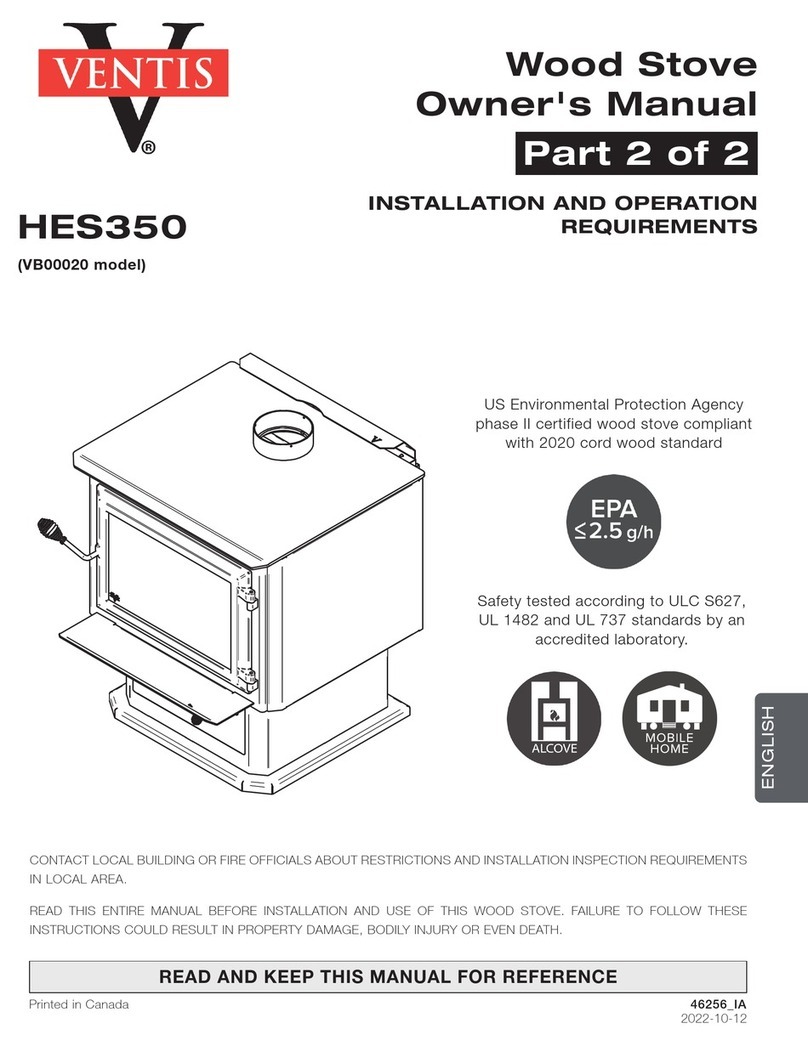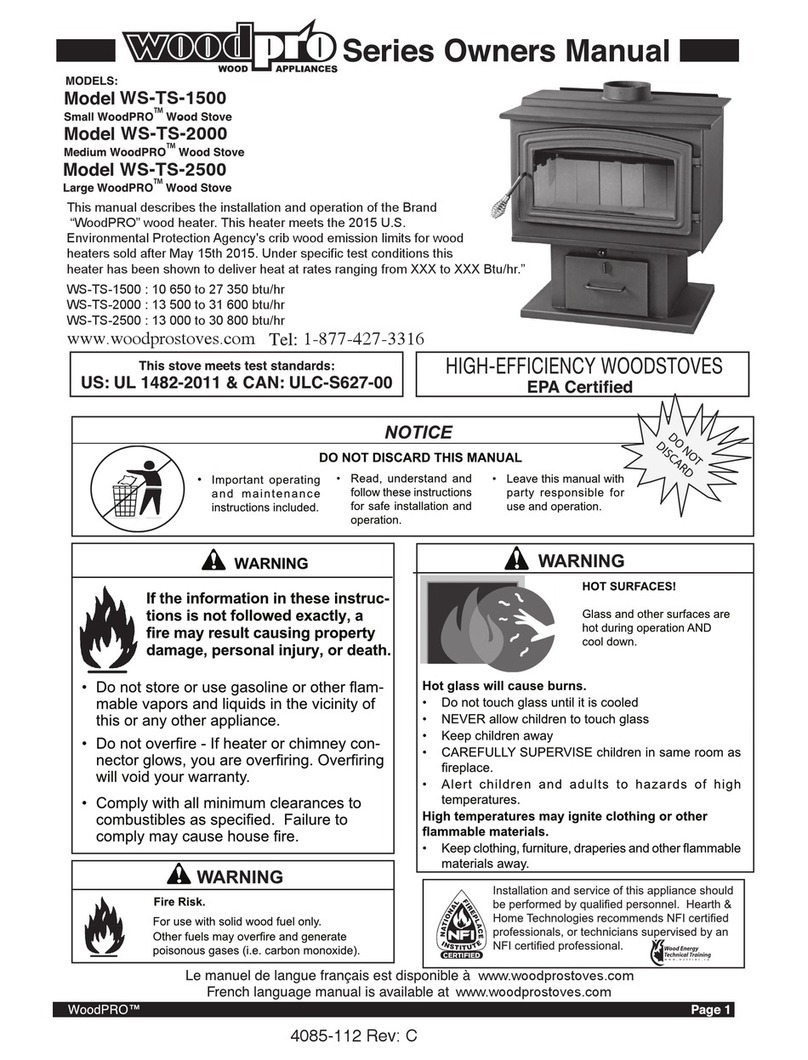1. The installation of this stove must comply with your
local building code rulings. Please observe the clear-
ances to combustibles (see reference ſIWTGU 4–8).
Do not place fuel, furniture or any other objects within
the clearance area.
2. Verify that the stove is properly assembled and
installed before ſring the stove for the ſrst time.
After reading these instructions, if you have any
doubt about your ability to complete noitallatsniruoy
properly, you must obtain the services of a
professional licensed installer familiar with all
aspects of safe and correct installation. DO NOT
use temporary or makeshift compromises
during installation. There must be NO DEVIATION
OR ALTERATION OF ANY KIND from the very spe-
ciſc instructions spelled out in this instruction manual
as it pertains to the installation of this woodstove.
NO EXCEPTIONS!
3. DO NOT store wood, kindling, ƀammable liquids
or other combustible materials in the vicinity of the
appliance. Refer to cerVKſECVKQP label on back of unit
and refGTGPEGſIWTGUKPVJKUOCnual.
4. FOR MOBILE HOME INSTALLATIONS IN U.S.A.
ONLY. DO NOT INSTALL IN MOBILE HOMES IN
CANADA. See additional mobile home require-
ments on page 11.
5. DO NOT ELEVATE THIS STOVE BY ANY MEANS.
(i.e. bricks under pedestal, cement blocks) Stove
pedestal must set directly upon the solid-surface non-
combustible ƀoor as speciſed in this stove instruction
manual.
6. DO NOT MODIFY THIS STOVE IN ANY !YAW
Stove must be installed with pedestal and ash drawer
provided, attached as shown in the instructions.
DO NOT OPERATE WITHOUT ASH DRAWER
OR ASH CLEAN OUT COVER IN PLACE –NO
EXCEPTIONS. Assemble only with original parts as
supplied and shown in this manual. DO NOT OPER-
ATE A STOVE THAT IS MISSING ANY PARTS! If
any parts are missing or defective, please notify
the dealer or manufacturer immediately. Replace
missing, broken or worn parts with factory original
or equivalent parts only.
7. CAUTION: DO NOT ALTER COMBUSTION AIR
CONTROL RANGE TO INCREASE FIRING OR
FOR ANY REASON. Altering or tampering with air
control beyond normal capacity will create unsafe
and hazardous conditions.
8. Always connect this stove to a chimney and vent to
the outside. Never vent to a room or inside a building.
DO NOT CONNECT THIS UNIT TO A CHIMNEY
FLUE SERVING ANOTHER APPLIANCE.
9. DO NOT CONNECT A WOOD BURNING STOVE
TO AN ALUMINUM TYPE B GAS VENT. This is
not safe. Use code-approved masonry chimney
with flue liner or a manufactured Underwriters
Laboratories Listed UL 103 HT (US)/ULC-S629
(CAN) Residential Type and Building Heating Ap-
pliance Chimney. Use a ŊOO diameter chim-
eeS(.tfarddoogaevigothguonehgihsitaht,yen
URGEKſEUKP%JKOPey Connections instructions).
10. Be sure that your chimney is safely constructed and
in good repair. Have the chimney inspected by the ſre
department or a SWCNKſGF inspector. Your insurance
company should be able to recommend a SWCNKſGF
inspector. Chimney connector pipe must be in good
condition. Replace if necessary before using stove.
11. Creosote or soot may build up in the chimney
connector and chimney and cause a house/building
ſre. Inspect the chimney connector and chimney
twice monthly during the heating season and clean
if necessary. (see Service Hints).
12. In the event of a chimney ſTe, turn the air controls to
closed positions, leave the building and CALL THE
FIRE DEPARTMENT IMMEDIATELY! Have a clearly
understood plan on how to handle a chimney ſTG by
contacting your local ſre authority for information
on proper procedures in the event of a chimney ſT .e
After the ſTG is out, the chimney must be cleaned
and inspected for any stress or cracks before starting
another ſre. Check the condition of any combustibles
surrounding the chimney.
13. Ashes should not be allowed to accumulate above
the top of the lower primary air oriſce (LPAO, air vent
CVHTQPVQHſTGDox, just inside of door, at the center).
14. DISPOSAL OF ASHES
Ashes should be placed in a steel container with
a tight ſVVKPI lid and moved outdoors immediately.
The closed container of ashes should be placed
on a noncombustible ƀoor or on the ground, well
away from all combustible materials, pending ſPCN
disposal. If the ashes are disposed of by burial in
soil or otherwise locally dispersed, they should be
retained in the closed container until all cinders have
completely cooled. Other waste shall not be placed
in this container.
15. To prevent injury, do not allow anyone use this stove
who is unfamiliar with the correct operation.
16. Do not operate stove while under the KPƀWGPEG of
drugs or alcohol or lack of sleep.
17. DO NOT ELEVATE THE FIRE. Build ſTG directly on
the bottom of the ſTGDox. This stove has not been
tested with the use of grates, andirons or other means
of elevCVKPIVJGſTGCPFmust not be used.
Page 2 WoodPRO™
SAFETY INSTRUCTIONS





























